In the shadows of Mount Vesuvius, the fertile lands of the Campania region of Southern Italy were once home to various groups of people since prehistoric times. They farmed the volcanic soils and left their traces of life buried under layers of sediment. In the 1990s, workers began clearing the land in the town of Gricignano d’Aversa to build the new U.S. Naval Support Site when they unearthed ancient artifacts. Within the ashen ground, archaeologists excavated the remains of villages and tombs that spanned roughly 4,000 years in history.
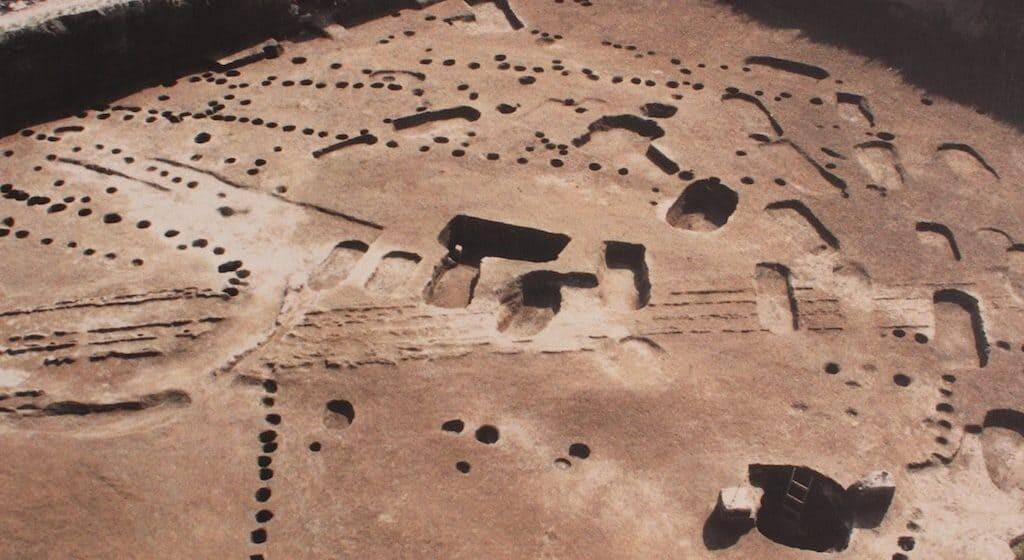
Settlements Interrupted by Volcanism
The Early Bronze Age villages of Campania were doomed. Around 1780 BCE, Mount Vesuvius erupted even more violently than it did in the cataclysmic event that devastated Pompei in AD 79. Called the Pomici di Avellino eruption, this explosion deposited about a billion cubic meters of ash as far as 25 kilometers away in Gricignano. It started with moderate outbursts of material that built up over a few hours and culminated in a devastating pyroclastic explosion. Thousands of people fled their villages in a NNW direction at the first signs of the suffocating fallout. Fortunately, most of them had enough time to escape the worst of the final blast. (Mastrolorenzo et al:2006).
In 2001, a chance discovery during the construction of a supermarket in the town of Nola, Campania, unearthed a Bronze Age village. Ash from the Avellino eruption had preserved the farm after its occupants fled with their cows. The scene was all too reminiscent of the ruins of Pompei.
[blockquote align=”none” author=”Mastrolorenzo et al.”]Scenes of everyday life, frozen by the volcanic deposits, testify that people suddenly left the village: the moulds of four huts, with pottery and other objects left inside; skeletons of a dog and nine pregnant goat victims found in a cage; and footprints of adults, children, and cows filled by the first fallout pumice.[/blockquote]
Gricignano d’Aversa, where the U.S. Navy would later build a base, was also home to a settlement that was devastated by volcanic activity. However, in addition to the Pomici Avellino eruption, the Agnano-Montespina event from around 2500 BCE left a thick layer at the site. Both eruptions caused villagers to flee and abandon the area for a significant amount of time – perhaps for a couple of hundred years.
Discoveries of Life and Death in Campania
Signs of ancient settlements surfaced during the early construction phase of the Gricignano U.S. Naval Support Site in the 1990s. Between 1995 and 2005 archaeologists from two different organizations conducted field excavations.
In total, the development area consisted of about 300 acres of land. Researchers began by surveying ten percent of each building area foundation, but if significant evidence turned up, they expanded their investigation area to the whole building site. (Vanzetti).
Gricignano Tombs
Archaeologists found a large Early Bronze Age village centered in the southeast section of the main commercial building area. In the eastern portion of the excavation site, there was a large necropolis (cemetery) that included 92 graves. Scientists estimated the remains to be between 2000-7000 years old. There were three types of burials within the complex: inhumation (burial of a corpse), cremation (incineration followed usually by urn burial), and enchytrismos (internment of a body inside an urn followed by burial of the urn).
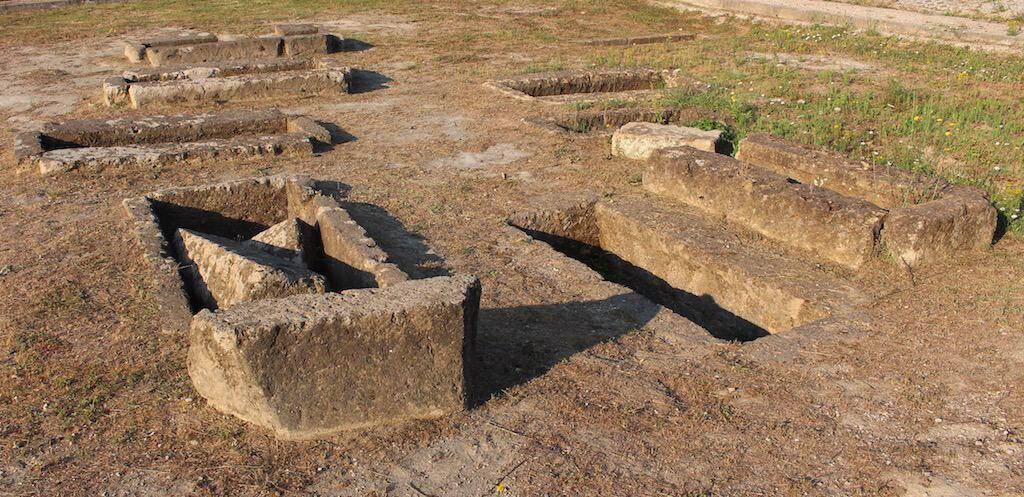
Of the 92 graves, 78 were in pits that contained inhumed or cremated remains. There were 14 enchytrismos burials. Commonly found in a number of ancient Greek settlements, enchytrismoi typically contain the remains of infants (Mawr). One body turned up in a well.
You May Also Like: The Celtic Prince of Lavau and His Opulent Tomb
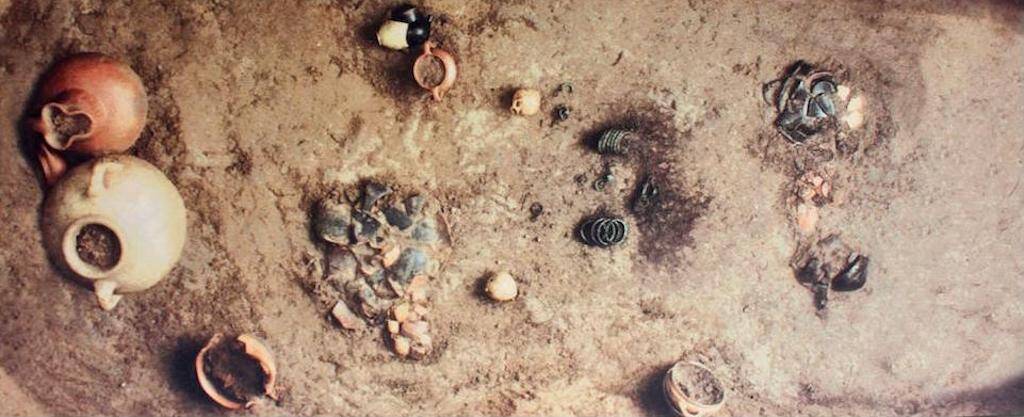

Additional smaller necropoli dotted the excavation sites and also dated to Neolithic, Bronze/Pomici, and Roman periods. Tomb styles varied with above-ground, pit/earth, and grotto/cave types.
In a number of the earlier burials, scientists found bodies in a fetal position or purposefully disarticulated. Some of the tombs mysteriously contained ceramic vases that had been broken beforehand and then subsequently placed with the deceased. Additionally, an abundance of grave goods, such as diverse ceramics, jewelry, fibulae for securing clothes, food items, weapons, and spindles, accompanied the dead.
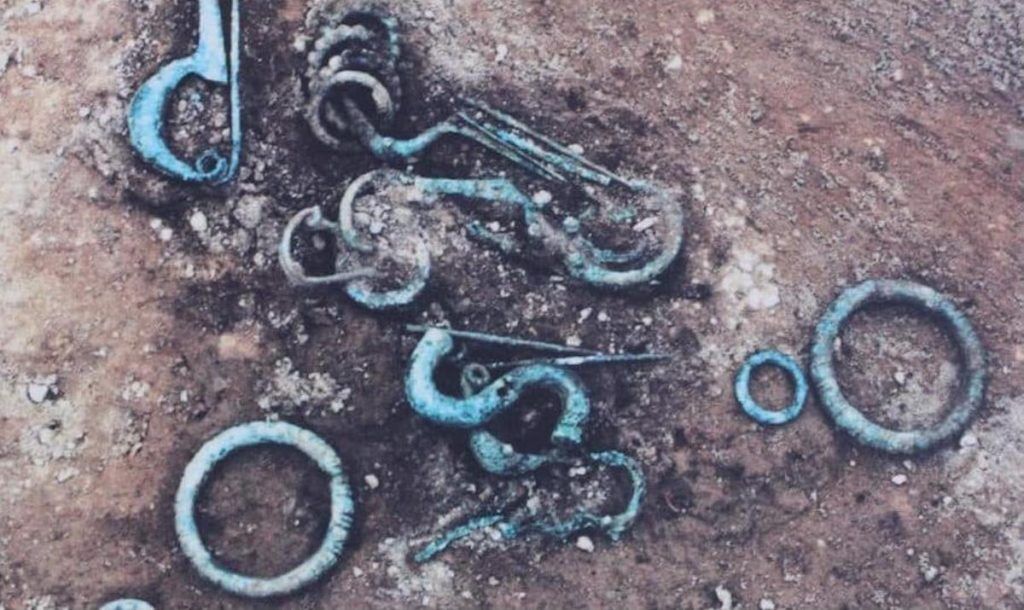
The Woman’s Grave
One notable burial contained the remains of a female who appeared to have been a person of some importance. Her caretakers had laid her on her back and covered her head with a veil that they secured with fibulae. A number of grave goods lay above her head and included jars for the containment and consumption of food. There were also sheep bones in another cup.
An amber necklace and rings still adorned her skeleton. Near her feet, archaeologists discovered a spindle, which was a common inclusion in female burials (however, a few male burials have also contained spindles). On the other hand, men were typically buried with weapons and tools. Other fibulae lay around the woman in places where they once secured her clothing.
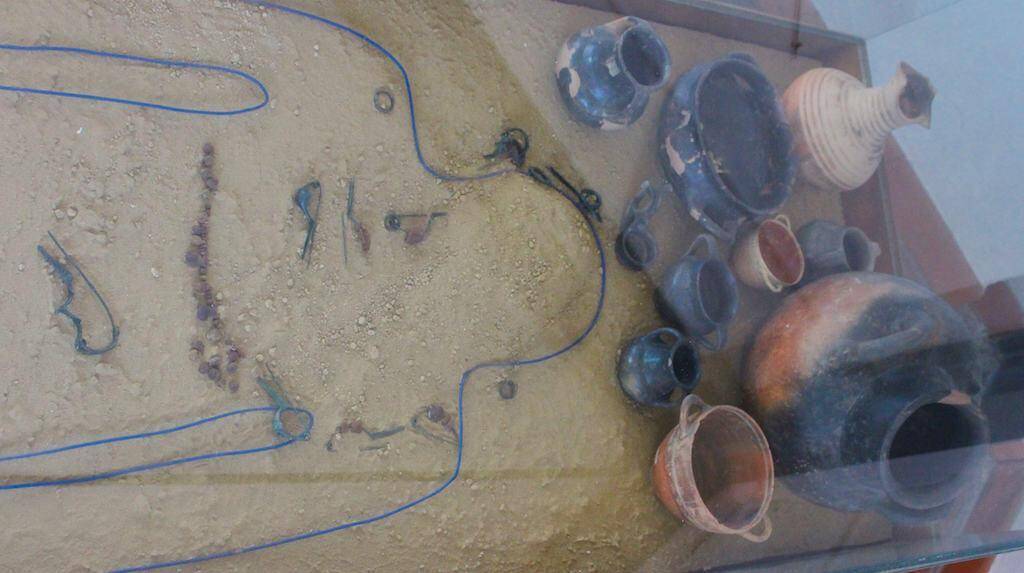
Large Neolithic Village
In addition to the large number of necropoli, a huge settlement dating to the Neolithic period surprised researchers. It measured nearly 70,000 square feet. Within that area, there were two large dwelling sites, one of which had a huge enclosure surrounding its perimeter. Holes that once held posts for various structures were discovered, and there appeared to have been a rounded corridor. Various huts and enclosed spaces also dotted the area, and animals and pottery filled various pits on the grounds. (Fasti).
Wells, Temples, and Cults
Of the many wells that dotted Gricignano, only some showed clear signs of water-collection. Other pits contained deposits of animal remains, tile, pottery, votives, and small female statues. These were probably involved in some type of cult rituals.
Around the zone of what would become the shopping area of the naval base, archaeologists found a large tract that was occupied sometime during the 4th-3rd centuries BCE until the Imperial period (1st-3rd century CE) by Romans. Within that space, piles of large blocks of tufa limestone revealed evidence of at least two temples. One was dedicated to Hercules, the god of war and victory, and the other to Venus Ericina, the goddess protector of navigators and prostitutes. Experts identified additional cult sites at altars, along with a number of pits filled with votives and statues. Deeper strata included Samnite wells, a complex dwelling area, and beaten roads.
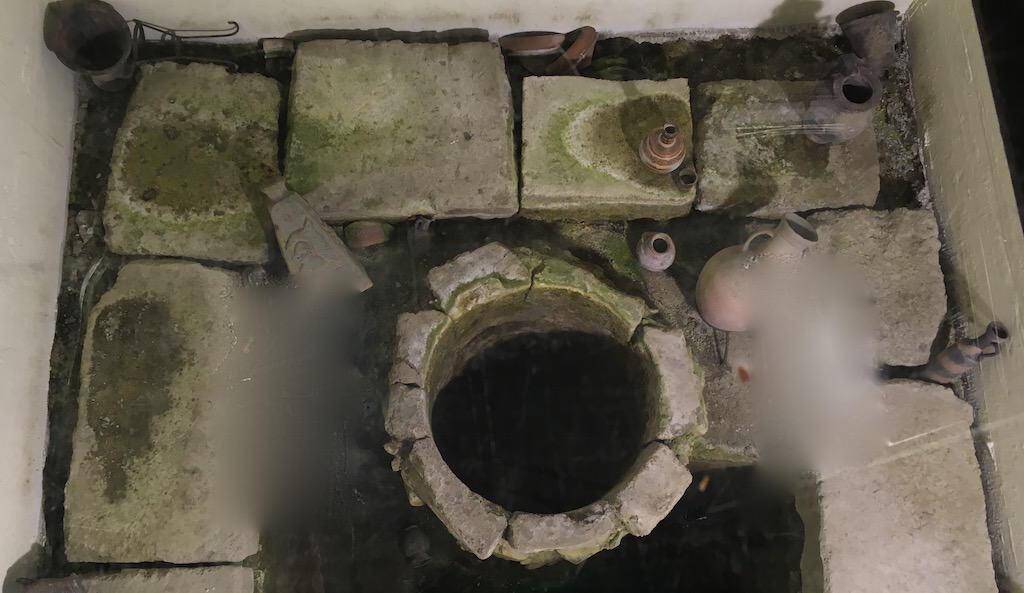
Ancient Roads
Older layers of the site revealed parallel Neolithic channels – perhaps plow furrows – and Bronze Age wheeled cart tracks. Under the Pomici eruption, 60 hectares, or 148 acres, of plowed fields revealed intense farming activity.
Later, beginning in the Roman Imperial age, beaten roads show clear signs of a typical Roman land division system called Centuriation. This was a type of land grid used to break up the areas of new colonies into plots of land for various usages. It also served as the foundation for city engineering and for assignment of lands to retired Roman soldiers. At Gricignano, Romans had built numerous earth-beaten roads in addition to a large main crossroad (decumanus) that ran in an east-west and north-south direction.
Who Lived in Campania?
The evidence clearly shows that Romans lived in Gricignano d’Aversa during the Imperial Age and into the Republic Age. This is consistent with what history tells us about how and when they conquered Campania. However, this doesn’t tell us about earlier humans who, in fact, have inhabited the Campania region for more than 300,000 years (Harper).
Etruscans
Specifically referring to the Aversa area where Gricignano is situated, experts are uncertain about the exact groups of people who first dwelt there. Probably various Italic tribes lived in the region during the Neolithic and Bronze ages. However, there is recent research that suggests the Etruscans may have founded Aversa (Cecere).
The powerful and wealthy Etruscans appeared around the 8th or 9th century BCE. This mysterious group possessed a language and customs that differed from the indigenous Italic groups. Etruscans were exceptional artists, metal workers, sailors, and merchants. They mainly controlled the areas around Rome and regions to the northwest of the city. However, they evidently expanded into the south as far as Salerno (Matthews). Additionally, important Etruscan cities emerged across their territories, such as Capua, and they interacted heavily with their Greek neighbors in Cuma and Neapolis (Naples). In fact, this might explain some of the Greek styles of vases discovered around Aversa and at the Gricignano excavation site.
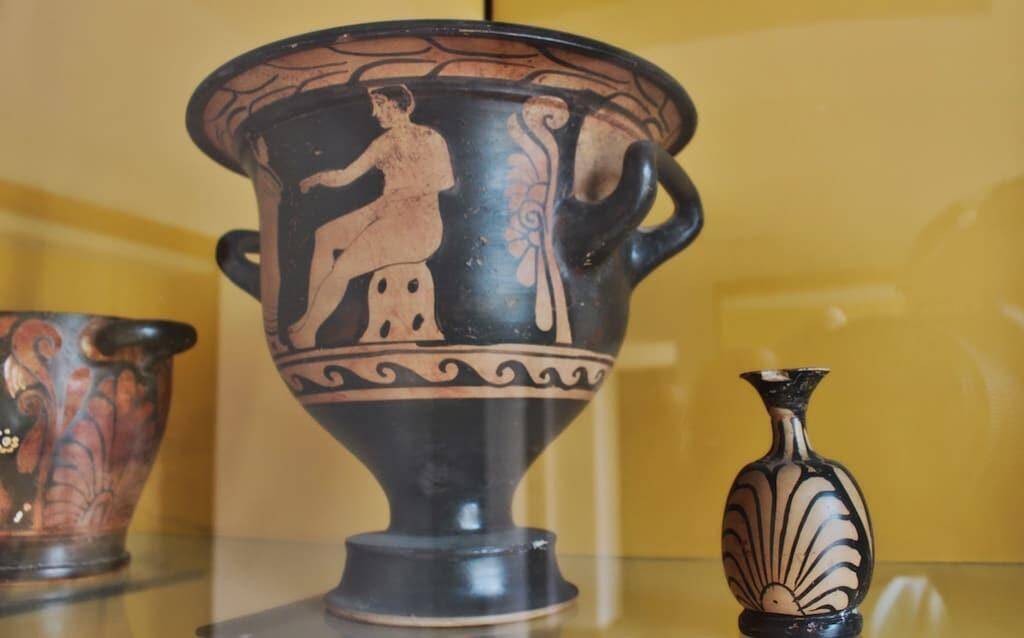
In about 600 BCE, the Etruscans reached the peak of their dominance.
[blockquote align=”none” author=”Polybius, The Histories, Book II (circa 150 BCE)”]The Etruscans . . . possessed also the Phlegraean plain in the neighbourhood of Capua and Nola, which, accessible and well known as it is to many, has such a reputation for fertility.[/blockquote]
Greeks, Romans, Samnites, Italics
Over the course of the first millennium BCE, the Campania region was home to various blended societies that, at times, coexisted. However, in general, groups rose to power and fell, making way for another group to take over. The Greeks fell to the Oscans at Cumae around 420 BCE. Then around 400 BCE, after the Etruscans weakened due to Celtic invasions and other wars, Samnites rose to power and took Capua. Subsequently, the Romans began fighting the Samnites for control and, in the 3rd century BCE, had taken the Nola/Aversa region. By the time of the founding of the Empire, the Romans had completely absorbed the Samnites, Etruscans, and any remaining Italic tribes. Subsequently, those cultures and languages disappeared.
You May Also Like: Derinkuyu: The Tumultuous History of Turkey’s Underground City
Life Cemented in History
The archaeological work conducted in Gricignano d’Aversa highlighted nearly 4,000 years of history. A wide range of artifacts sit on display at the Archaeological Museum of Agro Atellano and testify to the ethnic diversity and co-mingling of the region. Although the farmers of Campania suffered in the opera of deadly eruptions and persistent invasions, in their bitter end, their lives were preserved for us to discover and study more than two thousand years later.
References:
Archaeological Museum of Agro Atellano, Via Roma, 7, 81030 Succivo CE, Italy.
Fasti Online
Mastrolorenzo, Giuseppe, Pierpaolo Petrone, Lucia Pappalardo, and Michael F. Sheridan. “The Avellino 3780-yr-B.P. Catastrophe as a Worst-case Scenario for a Future Eruption at Vesuvius.” Proceedings of the National Academy of Sciences of the United States of America. March 21, 2006.
Polybius. ” p3 Fragments of Book XVI.” Histories – Book 16.
Vanzetti, Alessandro. “The Field System of Gricignano D’Aversa (Southern Italy) and the Agrarian Impact in the Piana Campana, Ca. 3900 Cal BP.” Quaternary International 303 (2013).